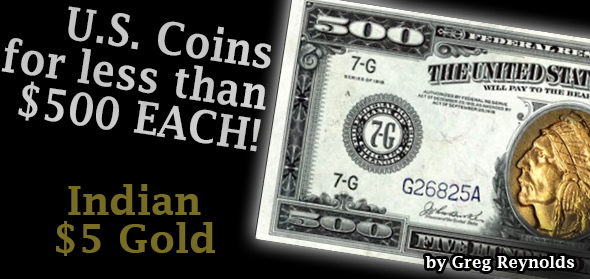
Coin Rarities & Related Topics: News and Analysis regarding scarce coins, coin markets, and the coin collecting community, #284
A Weekly Coinweek Column by Greg Reynolds….
For less than $500 per coin, a set of Indian Head half eagles ($5 gold coins) may be assembled that is missing just three dates.
Indian Head half eagles are specified to be 90% gold and each contains slightly less than a quarter of a Troy ounce of gold. These were minted from 1908 to 1916 and again in 1929. Indian Head half eagles were struck at the Philadelphia, Denver, New Orleans and San Francisco Mints.
The U.S. Mint did not produce gold coins in 1917 and 1918 for reasons relating to World War I. “There was not all that much demand for new gold coinage in the 1920s,” states researcher R. W. Julian. Background information regarding the design type may be found in a recent installment in this series on Indian Head quarter eagles, which are the little brothers of Indian Head half eagles. In some respects, they are almost identical.
This discussion is the sixteenth in a series about classic U.S. coins that cost less than $500 each. (Please click to read about defining classic U.S. coins or about Indian Head quarter eagles.) Although gem quality pieces tend to be very costly, circulated Indian Head half eagles overall are surprisingly inexpensive. Moreover, the most common Indian Head half eagles are much less plentiful than ‘common date’ Indian Head eagles ($10 gold coins) or Saint Gaudens double eagles ($20 coins), relatives in the family of early 20th century U.S. gold coins.
While common, thousands of Indian Head half eagles were not stored properly. Indeed, there are many that have been severely cleaned, badly scratched, bent, polished, etched, and otherwise harmed. While there are some wonderful early 20th century gold coins that have never been certified, the focus here is on those that are certified by PCGS or NGC, the two leading grading and authentication services.
PCGS & NGC Certification
When I write about coins that are PCGS or NGC graded, I have some idea as to the quality and overall appearance of the coins to which I am referring, even in cases where I have not examined the specific coins. I am not, however, recommending any of the specific coins mentioned herein, most of which I have never seen.
If I was told on the phone, by a reliable source, about a group of one hundred PCGS graded AU-55 Indian Head half eagles, in holders with blue labels, I could not envision the precise characteristics of any one coin, though I could conceptualize the contents of the group as a whole with considerable accuracy. This is one reason why common coins often trade ‘sight unseen’ in large groups.
Experienced buyers will know that such a group will contain some excellent coins and some awful ones. Some will be naturally brilliant while others will have been artificially brightened.
There is not a need to know much about any one coin in order to form an impression of the likely members of such a group. I have examined more than two thousand early 20th century gold coins and there are wholesalers who have each seen more than 100,000 of them. In many cases, the contents of a group could be evaluated to a curious and surprising extent, without precise knowledge of any one coin. In wholesale trading, experienced buyers will often subconsciously figure averages and probabilities in their minds before effecting transactions.
I am not recommending ‘sight unseen’ trading or any kind of speculation. I am certainly recommending against purchasing large groups of common coins.
I am directing a little attention now to this particular reality in the coin business for educational purposes. It is relevant to this discussion as Indian Head half eagles are often wholesaled privately rather than sold in live or Internet-auctions. It is also relevant that I have considerable ideas overall about the coins that I am mentioning without knowing the precise characteristics of any one of them. Even so, I recommend that collectors focus on individual coins rather than average coins in groups. Collectors should not act like wholesalers.
Importantly, I suggest that collectors aim to learn about the coins that they collect. In articles about rarities, I analyze individual coins. If it was practical for me to carefully inspect and report upon the precise characteristics of every coin that I mention, I would be delighted to do so. Properly analyzing coins requires considerable time.
Collectors may learn to successfully evaluate Extremely Fine to AU grade Indian Head half eagles in a relatively short amount of time if they concentrate, inspect many coins and consult relevant experts. It is a good idea to ask questions. Also, there is little downside risk in buying PCGS or NGC graded coins that cost less than $500.
Auction Results
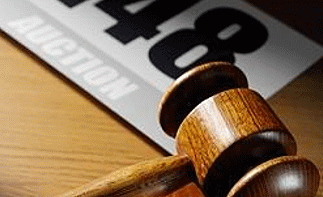 Although there are many variables that may relate to any one coin, or any one result, citing many auction results contributes to an understanding of the costs of particular collecting endeavors. Retail prices tend to be higher than auction prices, though, in some cases, auction results will be higher than retail prices.
Although there are many variables that may relate to any one coin, or any one result, citing many auction results contributes to an understanding of the costs of particular collecting endeavors. Retail prices tend to be higher than auction prices, though, in some cases, auction results will be higher than retail prices.
Ultimately, each collector must decide how much he or she is willing and able to spend on particular coins. Certified grades and auction results are two factors, though not the only factors, to take into consideration. It helps to learn at least a little about technical characteristics, variations in striking detail, and originality.
In my view, the grading of early 20th century gold coins by leading services has not been particularly consistent over the last twenty-eight years. Even so, the PCGS and NGC holders housing such coins are actively demanded even by dealers who have no intention of carefully examining the respective coins. Also, it is important that experts at PCGS and NGC authenticate these, as there are hundreds of fake Indian Head half eagles around.
There is much demand for ‘the holders.’ Indeed, telemarketing firms often sell certified, early 20th century coins to speculators who have no intention of examining the coins.
Overall, on average, buying Indian Head half eagles that are PCGS or NGC certified involves much less risk than buying those that are not so certified. Among Indian Head half eagles that cost less than $500 each, however, collectors who are able to authenticate and grade the coins themselves will often be able to obtain Indian Head half eagles for prices that are lower than the Internet sale results for certified coins that are cited herein. It is important to be careful when considering non-certified coins, as grading coins is more difficult than most collectors realize.
Collecting Strategy
Although a few fellow coin experts sharply disagree, I maintain that VF-35 to AU-55 grade Indian Head half eagles merit more attention and should be considered by budget-minded collectors who are interested in classic U.S. gold coins. In contrast, I find many ‘mint state’ Indian Head half eagles to be overvalued, in logical and cultural terms.
For most dates in this series, ‘mint state’ grade coins are readily available and collectors tend to buy those rather than circulated pieces. In my view, EF-45 to AU-53 grade Indian Head half eagles, with pleasant natural toning and no problems, are often excellent choices.
Indian Head half eagles that are PCGS or NGC certified as grading from MS-60 to MS-63 tend to be unappealing. These are often characterized by innumerable hairlines from cleaning, moderate scratches, clusters of contact marks, much friction, and/or unnatural brightness. Nevertheless, there are some terrific MS-63 and MS-62 grade Indian Head half eagles around. I suggest that the terrific pieces constitute a minority of those extant that are PCGS or NGC graded MS-62 or MS-63.
For most of the last forty years, MS-60 to MS-63 grade Indian Head half eagles have been promoted by marketing firms to buyers who know little about coins and/or who are not very interested in coins. Many such betters never inspect their coins; they often just place them in safe-deposit boxes.
Non-gradable, circulated and uncirculated pieces are promoted as well. These often have serious problems. Non-gradable coins are often mis-represented to prospective buyers who have almost no knowledge about coins or who do not care about the quality of the coins purchased. Some people knowingly buy and may even prefer coins that have been polished or doctored. I am not addressing those people in this discussion. In the traditions of coin collecting in the U.S., coins with excellent surface quality are held to be superior to coins that have been deliberately modified.
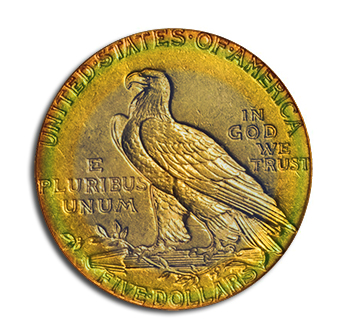 Most Indian Head half eagles are not naturally, very bright. They often have rich underlying luster that becomes lively when coins are tilted under lamps. Naturally toned Indian Head half eagles often exhibit russet tints or especially brownish-green hues. There are few shades and textures of green that are natural, though these do not vary widely. Experienced students of Indian Head half eagles learn to identify natural hues and artificial tones.
Most Indian Head half eagles are not naturally, very bright. They often have rich underlying luster that becomes lively when coins are tilted under lamps. Naturally toned Indian Head half eagles often exhibit russet tints or especially brownish-green hues. There are few shades and textures of green that are natural, though these do not vary widely. Experienced students of Indian Head half eagles learn to identify natural hues and artificial tones.
Blue toning does not naturally appear nearly as often on Indian Head half eagles as it does on Saints or Indian Head eagles, on which it very frequently develops. Blue patches on an Indian Head half eagle should be examined carefully with at least 5x magnification, as such patches may have been added to deflect attention from imperfections.
Shiny yellow Indian Head half eagles have usually been artificially brightened. Rich orange 1908-D half eagles might have been dipped as well, though the candy-orange results from dipping are often viewed favorably by graders at PCGS or NGC. There are some Indian Head half eagles, however, that feature a glowing, mellow orange texture that is truly natural.
Toning and natural color cannot be well explained in words. I suggest that beginners tend towards Indian Head half eagles with medium, brownish-green tones, as these are usually natural, stable and pleasing to the eyes of experienced coin collectors.
Those that grade from 58 to 64 are more likely to have been very apparently dipped than VF-30 to AU-53 grade Indian Head half eagles. For more than one reason, experienced collectors tend to be unenthusiastic about a substantial percentage of surviving, MS-60 to MS-63 grade Indian Head half eagles. I emphasize my view that circulated coins deserve more attention. After all, Indian Head half eagles that grade MS-64 or MS-65 are costly.
Even high quality representatives of the most common dates in the series are not cheap. The 1908 is one of the most common dates. As of June 29, the current CoinPlex bid for a PCGS or NGC graded MS-64 1908 is $1500. CoinPlex is an electronic system that allows dealers to communicate offers and trade with each other. CoinPlex is more useful for common coins than it is for rare coins.
Each $1500 bid on CoinPlex for a “MS-64” 1908 Indian Head half eagles is serious, though the respective bidder reserves the right to reject coins that are not found to be acceptable to him. Such offers are so called ‘sighted bids’ rather than ‘sight unseen’ commitments. Currently, however, there is a ‘sight unseen’ commitment to buy as many as ninety PCGS or NGC graded MS-64 1908 half eagles for $1760 each, provided that each coin has a sticker of approval from CAC. Retail prices are higher than CoinPlex bids.
As for MS-65 grade Indian Head Half Eagles in general, these currently retail for more than $8,000 each, for the most common dates. Are AU grade pieces that cost less than $500 each better values? Answers depend upon the respective tastes, preferences and budgets of individual buyers.
For buyers who are willing to spend no more than $500 for any one coin, there are many options and strategies that may be employed to build various sets or large overall collections of classic U.S. coins. Some such buyers are or will be glad that Indian Head half eagles may be enjoyably collected, given a $500 per coin maximum. Except for a 1909-O, a 1911-D, and a 1929, a whole set of Indian Head half eagles may surely be assembled.
1908
Coins of the first year of a new design type are often saved to a greater extent than subsequent issues. The 1908 Indian Head half eagle is not exception. These are common, though they are relatively much scarcer than 1924 Saints Gaudens double eagles or 1932 Indian Head eagles. Such relative rarity notwithstanding, there could well be more than 40,000 of them extant, including many that have been terribly polished for use in jewelry or other decorative objects. Certainly, there are more than 15,000 that are truly gradable. Many of these have not been certified because owners often figure that the costs of submitting them to PCGS or NGC outweigh the benefits of submitting.
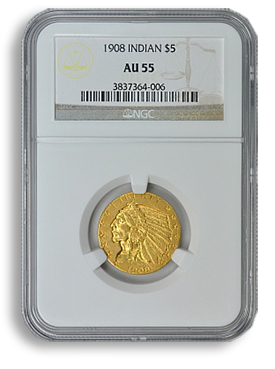 At the Long Beach Expo in September 2014, Heritage sold a PCGS graded AU-55 1908 for $470. Earlier, in June 2014, the firm called “GreatCollections” sold an NGC graded AU-55 1908 for $402.50. An EF-40 to AU-50 grade piece might be obtainable for less than $450.
At the Long Beach Expo in September 2014, Heritage sold a PCGS graded AU-55 1908 for $470. Earlier, in June 2014, the firm called “GreatCollections” sold an NGC graded AU-55 1908 for $402.50. An EF-40 to AU-50 grade piece might be obtainable for less than $450.
The 1908 Denver Mint issue is relatively scarcer than its Philadelphia counterpart, though is common as well. An AU grade 1908-D is certainly available for less than $500, though not many of these have been PCGS or NGC graded. A collector could buy one from a reputable dealer and submit it himself.
The 1908 San Francisco Mint issue is truly scarce and finding a decent 1908-S for less than $500 might not be easy. If fewer than 5000 exist in all grades, then a coin is truly scarce.
The numismedia.com value estimate for a VF-20 grade 1908-S is “$610.” Although the PCGS price guide value is below $500 for a VF-20 grade 1908-S, PCGS has not certified any in grade increments below VF-25. There is only one PCGS graded VF-30 1908-S. In September 2010, Heritage auctioned a PCGS graded VF-35 1908-S, one of nine so certified, for $632.50. Given a $500 per coin limit, there could be a need to settle for a non-gradable 1908-S or to find a gradable, raw coin.
1909
Finding an AU grade 1909 is easy. Recently, on April 14, 2015, Heritage sold a PCGS graded AU-58 1909 for $399.50. Last August, “GreatCollections” sold an NGC graded AU-58 1909 for $452.10.
One reason why certified AU-50 and AU-53 1909 coins are scarcer than certified AU-58 1909 Indian Head half eagles is that most of the people who owned AU-50 or AU-53 grade pieces never bothered to submit them, as there would be little to be gained from a financial perspective. It may also be true that a large percentage of surviving 1909 half eagles qualify for ‘mint state’ grades.
These often have green or russet tones. Very bright 1909 half eagles may not be particularly original.
Though not as common as the 1909 Philadelphia Mint issue, 1909 Denver Mint Indian Head half eagles are readily available. Less than a week ago, on June 25th, Legend Auctions sold a PCGS graded AU-53 1909-D for $381.88. In the EF-40 to AU-55 grade range, more than 1500 different 1909-D half eagles have been PCGS or NGC graded. Finding one for less than $500 would be easy.
The 1909-O is the key date and is famous. There is no point in trying to obtain a genuine 1909-O for less than $500. In September 2013, Heritage auctioned a 1909-O with “damage” in a PCGS Genuine holder, with the details of an Extremely Fine-40 grade coin, for $3,818.75.
Although the 1909-S is scarce overall, it is practical to figure that one could be obtained for less than $500. In October 2014, Heritage auctioned a NGC graded AU-50 1909-S for $381.88. About a month earlier, this same firm sold an NGC graded EF-45 1909-S for $470.
1910
The 1910 Philadelphia Mint issue is not as common as the 1908, though is very common. Several PCGS or NGC graded AU-55 or AU-58 1910 half eagles should be available for less than $500 each, in the current market climate.
Although the 1910-D is much scarcer than the 1910, there is not much demand for circulated 1910-D half eagles. A PCGS or NGC graded 1910-D could be found, within a short time, for less than $500. Less than a week ago, Legend auctioned a PCGS graded EF-45 1910-D for $411.25, a strong price.
Though not a rarity, the 1910-S is a slightly ‘better date.’ Even so, a substantial number of PCGS or NGC graded AU-50 to -55 1910-S half eagles have sold for well under $500 each over the last year. In March, Stack’s-Bowers sold a PCGS graded AU-50 1910-S for $387.75. On June 9, Heritage sold a NGC graded AU-55 1910-S for $452.38 and a different NGC graded AU-55 1910-S in January for $399.50.
1911
It is not difficult to acquire an AU grade 1911 for less than $500. In March 2014, Stack’s-Bowers sold a NGC graded AU-58 coin for $440.63. On Dec. 22, 2013, “GreatCollections” sold a PCGS graded AU-55 1911 for $401.50.
The 1911-D is a semi-key. A collector cannot assume that he or she will able to acquire one for less than $500 in the near future. Even so, it is worth the time to search for one in this price range. On May 12, 2013, “GreatCollections” sold a 1911-D in a PCGS Genuine holder for $579.70. It is non-gradable and has the details of an AU grade coin.
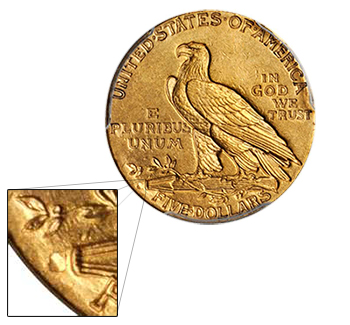
On Sept. 23, 2008, Heritage sold a PCGS graded VF-30 1911-D for $402.50. Admittedly, however, PCGS has only certified six as VF-30 and just two at lower grade levels. NGC has graded just one 1911-D as VF-30 and zero lower. For a coin such as this, though, if the seller is reputable and knowledgeable, it might make sense to buy a non-certified coin. It would be practical for a collector to show a non-certified, circulated 1911-D half eagle to multiple experts a major coin convention, or maybe to submit it to PCGS or NGC.
The 1911-S is a slightly better date. In December 2014, “GreatCollections” sold a PCGS graded AU-55 1911-S for $402.50. In March 2015, Stack’s-Bowers sold a PCGS graded and CAC approved EF-45 grade 1911-S for $376.
1912-13
The 1912 and the 1913 are among the most common dates in the series. These are easy to find. There are no 1912-D or 1913-D half eagles. The 1912-S and the 1913-S are not difficult to locate in circulated grades for less than $500 each, though gradable ‘mint state’ pieces are relative condition rarities.
During March 2015, Stack’s-Bowers sold a PCGS graded AU-53 1912-S, with a CAC sticker, for $448.85 and a NGC graded AU-55 1913-S for $423. A year earlier, Stack’s-Bowers auctioned a PCGS graded 1913-S, with an old green label in the holder, for $411.25.
1914
The 1914 Philadelphia Mint issue is not nearly as common as the 1912 or the 1913, though it is realistic to expect to find a certified 1914 for less than $500. At the ANA Convention in August 2014, Stack’s-Bowers sold a PCGS graded AU-55 1914 for $470. Earlier that same year, the same firm auctioned a PCGS graded EF-45 1914 for $381.88.
The 1914-D is the last half eagle that was struck at the Denver Mint. It is not rare. On Sept. 28, 2014, “GreatCollections” sold a PCGS graded AU-53 1914-D for $419.20. Within the last week, Stack’s-Bowers sold a PCGS graded and CAC approved, EF-40 1914-D for $352.50.
 The 1914-S is much scarcer than the 1914 and the 1914-D. Finding a gradable 1914-S for less than $500 might not be easy, though would not be extremely difficult. On Dec. 1, 2013, “GreatCollections” sold a NGC graded EF-45 1914-S for $375.10. In March 2015, Stack’s-Bowers auctioned a NGC graded AU-55 1914-S for $423.
The 1914-S is much scarcer than the 1914 and the 1914-D. Finding a gradable 1914-S for less than $500 might not be easy, though would not be extremely difficult. On Dec. 1, 2013, “GreatCollections” sold a NGC graded EF-45 1914-S for $375.10. In March 2015, Stack’s-Bowers auctioned a NGC graded AU-55 1914-S for $423.
1915
The 1915 is fairly common, though most survivors are in ‘mint state’ grades. When one is offered, an AU-50 or -53 grade 1915 will tend to sell for well under $500 in the current market climate.
The 1915-S is scarce. Certainly, there are fewer than 5000 in existence, many of which are in ‘mint state’ grades and are worth well over $500 each. Indeed, even a PCGS or NGC graded AU-53 1915-S will tend to sell for more than $500.
In March 2015, Stack’s-Bowers auctioned a NGC graded AU-50 1915-S for $364.25. In January, Stack’s-Bowers sold one in a NGC ‘Details’ holder that was said to have been ‘improperly cleaned’ and to have the details of an AU grade coin, for $411.25. When a 1915-S is available for less than $500, a collector building a set may wish to pursue it right away, as another in this price range may not be available for months or years.
1916-S
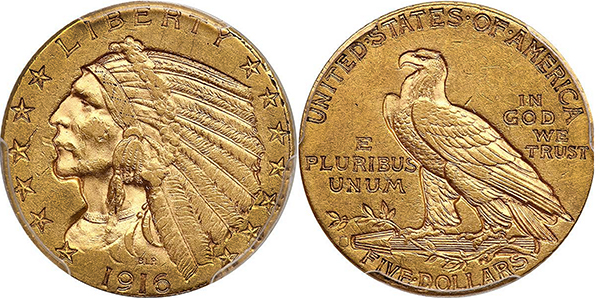
In 1916, half eagles were minted only at the San Francisco Mint. These are somewhat scarce, though much less scarce than the 1915-S.
In January 2015, the Goldbergs auctioned a PCGS graded AU-53 1916-S for $470. On March 1, Heritage sold a NGC graded AU-53 1916-S for $399.50. Curiously, a certified MS-64 1916-S could easily sell for more than $10,000.
1929
The 1929 is certainly extremely scarce and might be truly rare. There could be fewer than 500 in existence, though it is more likely that there are between 525 and 600. It has probably been more than five years since a genuine 1929 half eagle publicly sold for less than $10,000.
Conclusion
As the 1929 is from a later era, a set with dates from 1908 to 1916 seems complete enough without it. It is curious that no half eagles are dated from 1917 to 1928. Indian Head quarter eagles, in contrast, were minted from 1908 to 1915 and then from 1925 to 1929 inclusive. No Indian Head quarter eagles were minted in San Francisco. On the whole, with or without a $500 per coin limitation, Indian Head half eagles are more of a challenge to collect and are a little more complicated than Indian Head quarter eagles.
In sum, of the twenty four ‘dates’ (including U.S. Mint locations) in the series of Indian Head half eagles, representatives of twenty-one can probably be obtained for less than $500 each. Though not totally complete, a set of twenty-one would be fun to assemble and impressive when completed. The process of collecting a whole design type of U.S. gold coins ‘by date’ (and mint location), with a strict maximum of $500 per coin, could well turn out to be a fascinating game.
©2015 Greg Reynolds
Collectors who are interested in other types of classic U.S. coins, and prefer not to spend more than $500 on any one coin, may wish to read earlier parts of this series:
Copper-Nickel Indian Cents | Two Cent Pieces | Buffalo Nickels | Mercury Dimes | Standing Liberty Quarters | Bust Half Dollars | Liberty Seated Half Dollars | Barber Half Dollars | Walking Liberty Halves | Trade Dollars | Indian Head Quarter Eagles




